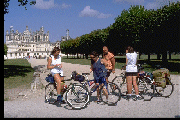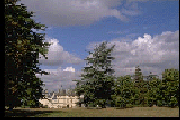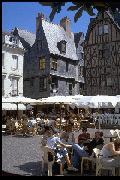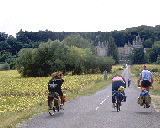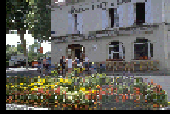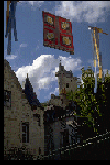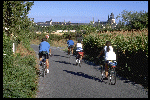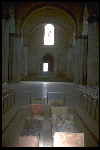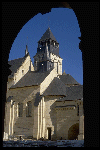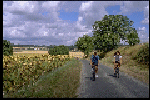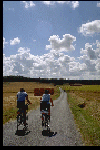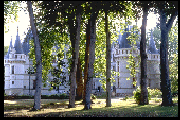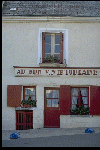|
|
||||||||||||||||||
|
FRANCE
1. Loire Valley
Blois-Tours-Chinon-Chenonceau-Blois.
Km.: 480 -Days: 6- Month: August
Click on thumbnails to zoom
The Loire Valley is the one
with the Castles, of course, but it has more than that. Which is a relief,
because whoever built them did not have bicycles in mind, and even today they
cater principally, especially the three-four most famous ones, to the
busloads of tourists that are discharged in the standard number of fifty or
so by the sleek, stylishly painted GT coaches with AC, TV, ABS and WTNT
(acronym for whatnot) that arrive and depart with a regularity that would
arouse the envy of their public transportation cousins. Luckily, their
itineraries follow equally predictable routes, and as a consequence, as soon
as one gets out these fixed paths, he gets some chances to discover some
relatively unspoiled spots in one of the most history-laden regions of
France. Our tour starts off in Blois,
a town that has history in abundance. It has its castle too. Loire Valley's
castles come mainly in two flavours: country castles and town castles and
Blois' is of the town variety. The French royal family used to spend some
time here in the Renaissance and post-Reformation periods, among them some of
the characters portrayed in that recent lavishly staged French feature film: "La
Reine Margot". To get the best view of Blois you have to cross the
river, which in this point is wide enough to provide an unobstructed
perspective of the whole town. From Blois we cycle out in a loop to visit Chambord,
Francis the 1st's sumptuous estate. Its vast grounds will make even a cyclist
happy, for once. We take advantage of the interminable alleys for a full-bore
Last-stage- of-the-Tour-the-France like sprint. From here we pedal on to Cheverny,
a beautifully proportioned XVII century mansion, which hints discreetly at
its own luxury... until you get to the ticket booth! Unwilling to spend the
whole afternoon here in order to recoup the price of the admission ticket, we
ride on, enjoying the sunny countryside, maybe only a bit too flat for those
among us who think cycling should not be a pastime for spoilt rotten softies.
Before getting back to Blois we make a detour to visit Beauregard Castle,
whose quiet and harmonious grounds are apparently a secret well kept from the
tourist hordes of the luxury coach variety.
On the second day of our tour
we follow the Loire for a first stop at Chaumont Castle, whose
charm is due in equal measure to its position high up on a hill overlooking
the Loire, its park where tall cedars, firs, and even sequoias dwarf
even the imposing bulk of the castle, and finally the building itself, one of
the more castle-like castles you may get a chance to see: it might have
provided the model for the Excalibur casino in Las Vegas... Today's ride ends
in Amboise, a very little town but also, unfortunately, the hub of the
Loire Valley's tourist traffic, which converges here to visit the castle
(this one belongs to the urban variety), as well as the Clos Luce'
mansion, where Leonardo da Vinci, that famous Italian expatriate (he
was also that, among other things), spent the last years of his life, under
the protection of the King, Francis the 1st (you may have wondered why the Monna
Lisa painting was in Paris).
The next day we take a short
ride and spend most of the day to visit Tours, the region's main city,
a sort of quintessential French provincial town. All those Hollywood fella
who have lately shown a tendency to characterize French people as rude and
haughty have never set foot around here, evidently. Apart from their
unpronounceable name, "Les Tourangeaux" seem to have very
few shortcomings: they are charming, friendly, and unfailingly hospitable.
The city itself offers a smorgasbord of artistic and cultural
attractions. First of all, on account of its saint protector, the bishop Martin
(St Martin of mantle fame but also, on a more historic perspective, the
patriarch of French monasticism). We are careful also not to miss the Cathedral,
a gothic masterpiece that has a unique set of stained glass windows, and the
medieval city centre, today mainly a car-free area (and, oddly enough,
situated quite a long walk away from the cathedral), whose narrow alleys,
bordered with wooden-beamed facades, converge to the busy Place Plumereau.
The following day's route has
something for everyone: cyclists (about time), castle buffs (those who are
not fed up with them yet), and even botany freaks, whose only regret
will be not to have the weeks it would take to visit comme il faut the
unbelievable gardens of Villandry, where
plant name-tags outnumber even the cards of your average town council
library. Crossing and re-crossing the Loire we get to see (you guessed
right) some more castles: the slightly forbidding Langeais, and Usse',
which stands on a wooded escarpment near the confluence of the Indre
and the Loire, and whose vaguely dreamy, hypnotic, slumbering settings
(call it what you want) sits well with the lore according to which it
inspired Perrault to write his Sleeping Beauty tale.
As we leave the Loire
behind, the terrain becomes hilly, with both the landscape and the cycling
benefiting from it. Amidst those undulations sits Chinon, the town
I've been waiting for to finally get to use the adjective "quaint"
(I wanted to use it sparingly...). Like Blois and Amboise, Chinon is built
along a river, not the Loire this time, but the Vienne. Not
much remains of its castle, but at this point nobody dares complain, for fear
he'll be taken to the nearest psychiatric ward... The historic interest is by
no means diminished: Chinon hosted the Court when Joan of Arc came to
meet the Dauphin (which literally means dolphin in French but in those
times designated also the heir to the throne; a mistake was highly improbable
in any case: the sea is still kilometres away), and to incite him to chase
the "godons" (this one being a derogatory term for
Britons... those of that age, anyway) away from Orleans and out of France. If
you forget this one, you'll be reminded when you come here (and doubly so if
you are British, I expect).
History, art, and
some of the most charming landscapes in the whole region are reason enough
for us to start off on a loop around Chinon that takes us to Fontevraud
Abbey, a huge monastic complex built around its stately Romanesque
church, which was, among other things, Alienor of Aquitaine's
favourite nunnery. Alienor was a sort of Princess Diana for that epoch's
Elton Johns (known as the troubadours), but unlike that other unlucky divorcée
(Alienor had a first marriage with Louis VII of France annulled), she
eventually managed to become Queen of England by marrying Henry II Plantagenet
(the one who made to Archbishop Thomas Beckett an offer he couldn't refuse
-though not for lack of trying...) Among the offspring of this famous menage
where the equally well-known Richard Lionheart and John Lackland.
Following her explicit request, after her death Alienor was buried in the
church at Fontevraud, and her tomb can still be found here alongside those of
her husband and of her favourite son, Richard. We return to Chinon by
crossing some hills where the opulence of the land reminds us that this is
the country of Francois Rabelais (he was born somewhere around here),
the author of Gargantua et Pantagruel. In this tale, the two
characters of the title are giants whose appetite for bread, beef, pork and
wine is more than a match for the most fertile land, except perhaps the one
that Rabelais remembered from his infancy.
At this point we turn our cap
around 180 degrees to begin our return ride to Blois. In two days we visit
two of the most famous castles in the Loire Valley: Azay-le-Rideau and
Chenonceau. What can be said of those two that hasn't already been
said? Perhaps, that in neither one you'll be allowed to take your bike
inside (and this
means not even in the park), and that both are renowned for their son et
lumière shows, especially the last one, where you can get a glimpse of
the show also from outside the grounds, and save the price of the ticket in
the process. Take the rue Nationale and follow the stream keeping the
castle on your left until you get out of the village. Until Chenonceau you'll
get mostly busy roads, but then the heavy traffic turns toward Amboise, and
from that point until Blois most of the ride takes place in the open
countryside, with very little traffic, and, aside from a number of little
hamlets, only a couple of larger villages, both interesting: Montrichard
and Pontlevoy. Click
here to go to Part II: Brittany.
[Home Page]-|-[ France]-|-[ Ireland]-|-[ Italy]-|-[ Germany]-|-[ Scotland]-|-[ United States]
|


